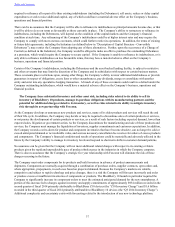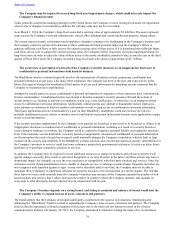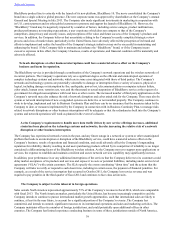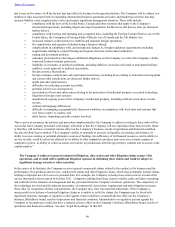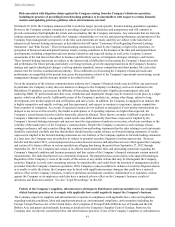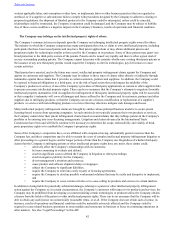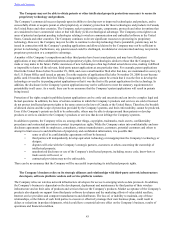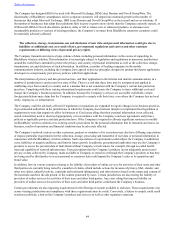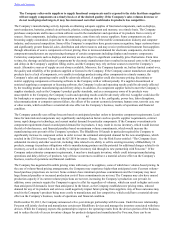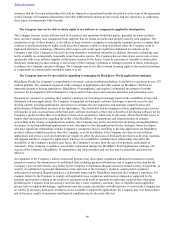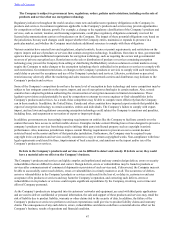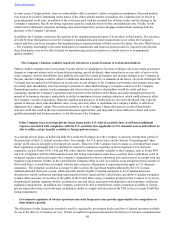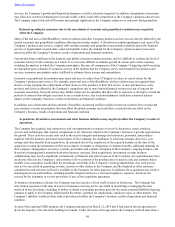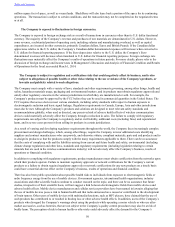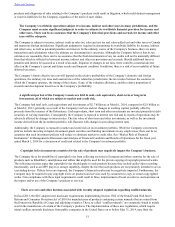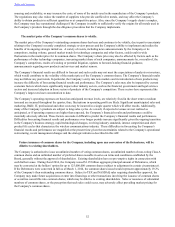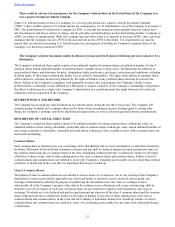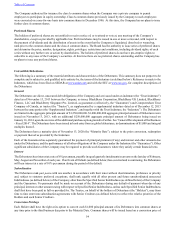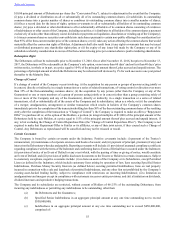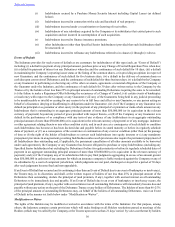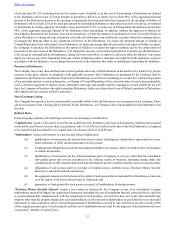Blackberry 2014 Annual Report Download - page 55
Download and view the complete annual report
Please find page 55 of the 2014 Blackberry annual report below. You can navigate through the pages in the report by either clicking on the pages listed below, or by using the keyword search tool below to find specific information within the annual report.
47
The Company is subject to government laws, regulations, orders, policies and restrictions, including on the sale of
products and services that use encryption technology.
Regulatory initiatives throughout the world can also create new and unforeseen regulatory obligations on the Company, its
products and services. Government regulations applicable to the Company’s products and services may provide opportunities
for competitors or limit industry growth. For example, a change to the regulatory classification of the Company’s products and
services, such as content, taxation, and licensing requirements, could place regulatory obligations commonly reserved for
licensed telecommunications carriers or broadcasters on the Company. The impact of these potential obligations vary based on
the jurisdiction, but any such changes could impact whether the Company enters, maintains or expands its presence in a
particular market, and whether the Company must dedicate additional resources to comply with these obligations.
Various countries have enacted laws and regulations, adopted controls, license or permit requirements, and restrictions on the
export, import, and use of products or services that contain encryption technology. In addition, from time to time, governmental
agencies have proposed additional requirements for encryption technology, such as requiring the escrow and governmental
recovery of private encryption keys. Restrictions on the sale or distribution of products or services containing encryption
technology may prevent the Company from selling or distributing the BlackBerry wireless solution in certain markets or may
require the Company to make changes to the encryption technology that is embedded in its products or services to comply with
such restrictions. Government restrictions, or changes to the Company’s products or services to comply with such restrictions,
could delay or prevent the acceptance and use of the Company’s products and services. Likewise, restrictions or perceived
restrictions may adversely affect the marketing and sales resources that network carriers and distributors may dedicate to the
Company’s products and services.
Some of the Company’s competitors do not have the same level of encryption in their technology and some competitors may be
subject to less stringent controls on the export, import, and use of encryption technologies in certain markets. Also, several
countries have adopted legislation authorizing the circumvention of encryption measures in limited circumstances. These
legislative provisions could potentially be used by competitors to attempt to reverse engineer or find vulnerabilities in the
Company’s products and services. As a result, these competitors may be able to compete more effectively than the Company
can in those markets. In addition, the United States, Canada and other countries have imposed export controls that prohibit the
export of encryption technology to certain countries, entities and individuals. The Company’s failure to comply with export,
import, and use laws and regulations concerning encryption technology could subject the Company to sanctions and penalties,
including fines, and suspension or revocation of export or import privileges.
In addition, governments are increasingly imposing requirements on entities like the Company to facilitate controls over the
content that users have access to on their mobile devices. Examples include content filtering laws or laws designed to prevent a
company’s products or services from being used to infringe third party intellectual property such as copyright in artistic
performances. Also, numerous jurisdictions impose content filtering requirements to prevent access to content deemed
restricted based on the norms and laws of that particular jurisdiction. Furthermore, the Company may be required to pay
copyright levies on products and services used by consumers to copy or stream copyrighted works. Non-compliance with these
legal requirements could result in fines, imprisonment of local executives, and sanctions on the import and/or use of the
Company’s products or services.
Defects in the Company’s products and services can be difficult to detect and remedy. If defects occur, they could
have a material adverse effect on the Company’s business.
The Company’s products and services are highly complex and sophisticated and may contain design defects, errors or security
vulnerabilities that are difficult to detect and correct. Design defects, errors or vulnerabilities may be found in products or
services after commencement of commercial shipments or provision of such services and, if discovered, the Company may not
be able to successfully correct such defects, errors or vulnerabilities in a timely manner or at all. The occurrence of defects,
errors or vulnerabilities in the Company’s products or services could result in the loss of, or delay in, customer or end user
acceptance of its products or services and may harm the Company’s reputation, and correcting such defects, errors or
vulnerabilities in its products or services could require significant expenditures by the Company, involving cost or time and
effort of Company personnel.
As the Company’s products are integrated into its customers’ networks and equipment, are used with third party applications
and are used to deliver confidential or personal information, the sale and support of these products and services may entail the
risk of liability due to product liability, warranty or other claims tied to the security of data. In addition, the failure of the
Company’s products or services to perform to end user expectations could give rise to product liability claims and warranty
claims. The consequences of any such defects, errors, vulnerabilities and claims could have a material adverse effect on the
Company’s business, results of operations and financial condition.
Table of Contents


